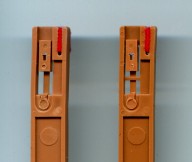Technical Library
ACTION IX: Tongue adjustment
Entire Contents Copyright © 2010 CBHTechnical LibraryACTION IX: Tongue adjustment Entire Contents Copyright © 2010 CBH |
 |
| Back view of two Zuckermann brown plastic #6 jacks used since 1979: The later refinement on the right has the tongue spring support web. |
Tongue adjustment…
The plucking mechanism of the harpsichord relies on the correct operation of
the tongue. A tongue that dithers around in mid-air will not allow the quill
to reliably pluck the string. Therefore, no matter what type of jack, it is
essential that the tongue is always positively and rapidly returned to rest
by its spring.
The spring tension is quite critical. If too loose, the tongue will only be vaguely returned and repetition unreliable. If too great, it is quite likely that the quill will want to hang on the string instead of flipping below, ready to play the note again.
We have movies prepared to show the process of tongue replacement and adjustment in three common types of harpsichord jacks used today: The simple wooden jack, the Zuckermann brown plastic #6 jack, and the Hubbard white plastic jack with top and bottom adjustment screws. Each movie has accompanying explanatory text.
| Technical Library overview | |
| Harpsichords Australia Home Page |